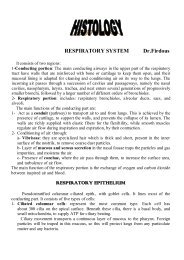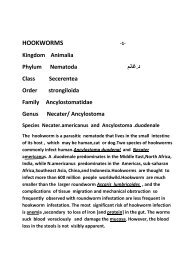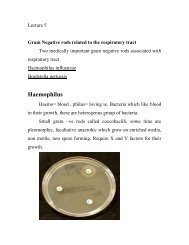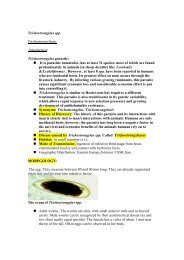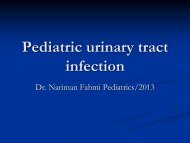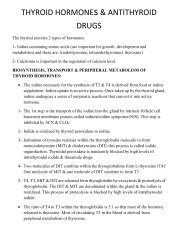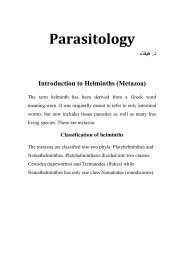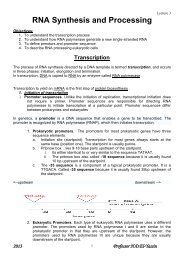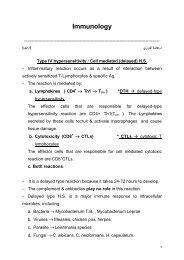Strongyloides sterocoralis
Strongyloides sterocoralis
Strongyloides sterocoralis
Create successful ePaper yourself
Turn your PDF publications into a flip-book with our unique Google optimized e-Paper software.
<strong>Strongyloides</strong> <strong>sterocoralis</strong><br />
•Objective: S.<strong>sterocoralis</strong> is important human parasite ,because of its potential fatal<br />
hyperinfection syndromein immunocompromised persons ,also recent study shows<br />
that chronic alcoholism itself is an important factor that predispose factor to<br />
strongyloidiasis.<br />
• Kingdom:Animalia<br />
• Phylum:Nematoda<br />
• Class:Secernentea<br />
• Order:Rhabditida<br />
• Family:Strongyloididae<br />
• Genus:<strong>Strongyloides</strong>Species:S. stercoralis<br />
• <strong>Strongyloides</strong> stercoralis ,also known as the threadworm, is the scientific name of<br />
a human parasitic roundworm causing the disease of strongyloidiasis.<br />
Infectious Agent :<br />
• Strongyloidiasis is caused by an intestinal nematode, <strong>Strongyloides</strong><br />
stercoralis, which is the smallest pathogenic nematodes ,hardly<br />
visible to the naked eye measure 2.4-4.7mm. in length. It is a<br />
potentially fatal opportunistic pathogen in immunocompromises<br />
hosts .<br />
Habitat: is the mucosal epithelium of upper small intestine(s.i.).<br />
Geographic distribution :<br />
1.S. stercoralis has a very low prevalence in societies where fecal<br />
contamination of soil or water is rare. Hence, it is a very rare infection<br />
in developed economies,in Iraq also the infestation is rather rare. In<br />
developing countries it is less prevalent in urban areas than in rural<br />
areas (where sanitation standards are poor). S. stercoralis can be<br />
found in areas with tropical and subtropical climates.<br />
2. Estimates of global prevalence vary between 3 million and 100 million.<br />
Mode of Transmission:<br />
• Filariform larvae found in infected soil in the tropics and<br />
subtropics penetrate human skin .<br />
• Person-to-person transmission is rare, but has been documented.<br />
Risk for Travelers :<br />
• Travelers who visit endemic areas and have contact with<br />
contaminated soil through bare skin are at risk for infection .<br />
1
• Most infections seen in the United States occur in immigrants,<br />
refugees, and military veterans who have lived in endemic areas for<br />
long periods of time .<br />
• Risk for short-term travelers appears to be very low, but can occur.<br />
Signs and Symptoms :<br />
• Most infections are asymptomatic.<br />
• Dermatitis (with acute infections) is produced by migration of the infective<br />
juveniles through the skin (cutaneous infection) ,migrating larvae in the skin<br />
can cause larva currens, a serpiginous urticarial rash.<br />
• The mild to severe symptom of pneumonia can occur during migration to airsacs<br />
of lungs. (Cases of reproduction in the air-sacs have been observed but<br />
they are relatively rare).<br />
• Inflammation of the intestinal mucosa.<br />
• Diarrhea accompanied by emaciation and exhaustion.<br />
• Immunocompromised individuals, especially those receiving systemic<br />
corticosteroids or patients with HTLV-1 infection, are at risk for<br />
hyperinfection or disseminated disease, characterized by abdominal pain,<br />
diffuse pulmonary infiltrates, and septicemia or meningitis from enteric gramnegative<br />
bacilli. Untreated disseminated strongyloidiasis has high mortality.<br />
• Unexplained eosinophilia may be a presenting sign of strongyloidiasis.<br />
Morphology :<br />
The different stages of S.<strong>sterocoralis</strong> are :1.adult<br />
worms,2.eggs,3.larvae(rhabditiform laravae,and filariform larvae).<br />
1.adult worms : Only female are seen in the intestine .Majority of the female<br />
worm are parthenogenetic(i.e. they can produce offspring without<br />
being fertilized by the male).Contrary the male worms do exist,<br />
which are shorter and boarder than the female, while males grow to<br />
only about 0.9 mm in length, the females can be anywhere from 2.0<br />
to 2.5 mm.While intestine is present in the posterior 2/3 of the<br />
body, the posterior end is pointed .The eggs are arranged anteroposteriorly<br />
in a single row of 5-10 eggs in a uterus, the female is<br />
ovo-viviparous. The males are not seen in human infections<br />
because they do not invade the intestinal wall and are<br />
eliminated from the intestine. Both genders also possess a tiny<br />
buccal capsule, the mouth possess 3-small lips and cylindrical<br />
esophagus (without a posterior bulb) is present in anterior part of<br />
2
the body. In the free-living stage, the esophagus of both sexes are<br />
rhabditiform. Males can be distinguished from their female<br />
counterparts by two structures: the spicules and gubernaculum.<br />
2. Eggs : The ovum is oval,transparent,thin shelled,about 5-60μm*30-<br />
35μm,partially embryonated when discharged in mucosal epithelium. Eggs<br />
typically mature into rhabditiform larvae within the intestine.<br />
<strong>Strongyloides</strong> is the only helminth to secrete larvae (and not eggs) in<br />
feces .<br />
Unmbryonated and embryonated<br />
ova of S.<strong>sterocoralis</strong> .<br />
3.Larvae : Two types of larvae are found :rhabditiform and filariform larvae. the<br />
embryonated eggs hatch almost immediately in the mucosa of the intestine<br />
to the rhabditiform larvae.<br />
A.Rhabditiform larvae: These are developed directly from gravid females and are<br />
found in the lumen of the bowel, are short in length than filariform larvae and<br />
sluggishly motile ,and have short mouth and double bulb oesophagus.<br />
The further course of development could be by either a. internal reinfection or by<br />
b.external reinfection or hyperinfection through penetrate the perianal&perneal<br />
skin without leaving the host, c. or by may be voided with faeces and undergo<br />
development in the soil through direct or indirect cycle .<br />
B.Filariform larvae:These are skin penetrating infective forms of the parasite<br />
,which are longer and more slender than the rhabditiform larvae, they have short<br />
mouths and cylindrical esophagus. These are develop in three ways:metamorphosed in<br />
human bowel from the first batch of rhabditiform larvae,direct development from<br />
rhabditiform larvae (in temperate climates),and from a sexual phase of rhabditiform<br />
3
laravae in the soil giving rise to second rhabditiform larvae and then developed to<br />
filariform larvae(in tropical climates).<br />
The Life Cycle of S.<strong>sterocoralis</strong> : Man is the only host of S.<strong>sterocoralis</strong><br />
,and no I.H. is required and the change of the host is not essential.<br />
• worms have a heterogenetic life cycle which consists of :<br />
1. A free-living generationis called (heterogonic life cycle):<br />
The mating take place in the soil and fertilized female lays<br />
eggs ,which hatch to release the next generation of<br />
rhabditiform larvae that either repeat the life cycle or may<br />
develop to into filariform larvae which infect man and initiate<br />
the parasitic phase.<br />
2. A parasitic generation which is internal and external<br />
autoinfection is called (homogenic life cycle).<br />
Infection occurs when exposed skin contacts contaminated soil, following skin<br />
penetration they are carried by the blood to the lungs, where they exit into the<br />
alveoli, travel up the trachea, are swallowed, and mature in the small intestine. If<br />
ingested, migration through the lungs is not necessary.<br />
Filariform larvae rest in the small intestine, mature into adult females. A parasitic<br />
females anchor themselves with their mouths to the mucosa of the small intestine<br />
or burrow their anterior ends into the submucosa. Reproduction in the host is by<br />
parthenogenetic females which lay several dozen eggs each day. Eggs are released<br />
into the lumen of the gut or the submucosa where they hatch and juveniles pass<br />
into the lumen. These first-stage juveniles are 300-380µm long and are usually<br />
passed with the feces. Juveniles develop either to free-living adults or to infective<br />
filariform juveniles. Third stage juveniles(filariform larvae) are the infective stage.<br />
They are 490-630µm long. This is a resting stage which does not develop further<br />
until it penetrates through skin or is ingested.<br />
4
Clinical Features:<br />
Often asymptomatic yet cause mild to severe abdominal symptoms,but a<br />
charactaristic sign of strongyoidiasis is larva currens .<br />
• Under certain conditions (e.g, constipation, decreased bowel motility,<br />
diverticular disease), the larvae do not exit the host in feces and<br />
instead molt into the infective filariform .<br />
Recent studies shows that the hyperinfection is associated with a dramatic<br />
increase in the number of parasites and the progression to clinical manifest<br />
dissemination seems to be related with an increase in the successful rate of<br />
molting.<br />
5
Laboratory of diagnosis of S.<strong>sterocoralis</strong> :<br />
1. Stool examination ,only larvae of the parasite can be detected(either rhabditiform<br />
or filariform larvae will confirm the presence of this parasite. Repeated stool<br />
examinations may be necessary, given the low sensitivity of a single stool<br />
examination.<br />
a. Direct wet smear examination ,by using either (direct saline or iodine smear)is<br />
examined for the presence of larvae.<br />
b. Formal –ether concentration: this method is more sensitive than the direct smear<br />
examination .<br />
c. Concentration of larvae by Baermann's method ,this method depends on the<br />
principle of the tendency of strongyloides larvae to migrate from a colder to warmer<br />
area.this is the most sensitive method available for diagnosis.<br />
2.Stool culture :using charcoal culture method , filariform larvae develop in 5-7days<br />
in positive cases.<br />
3.Duodenal aspiration :using enterotest gelatin capsule (repeated examination is<br />
recommended) .This is also a very sensitive mewthod.<br />
4.Histopathological examination :biopsy or autopsy specimen.<br />
5.Immunodiagnosis : like ELISA ,RAST( used for screening from individuals from<br />
endemic area who are likely to put on immunosuppressive therapy.<br />
6



